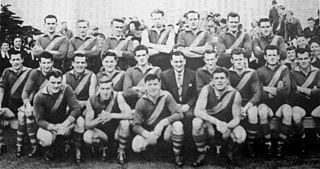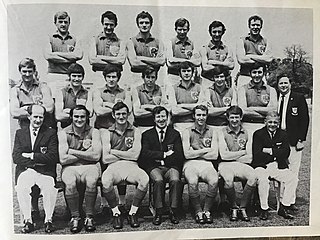Related Research Articles

The Brighton Football Club, nicknamed the Penguins, was an Australian rules football club based in the Melbourne suburb of Brighton. The club was a founding member of the Metropolitan Junior Football Association (MJFA) in 1892, before moving to the Victorian Football Association (VFA) in 1908.

The Dandenong Football Club, nicknamed the Redlegs, was an Australian rules football club based in the Melbourne suburb of Dandenong. The club competed in the Victorian Football Association (VFA) from 1958 until 1994.

The Sunshine Football Club, nicknamed the Crows, was an Australian rules football club which played in the Victorian Football Association (VFA) from 1959 until 1989.

The Moorabbin Football Club, nicknamed the Kangaroos, was an Australian rules football club best known for its premiership success in the Victorian Football Association (VFA) during the 1950s and 1960s. During their time in the VFA, the club played its home matches at Moorabbin Oval and wore blue and white hooped guernseys. It previously achieved success in the Federal Football League, winning 12 premierships.
The 1948 Victorian Football Association season was the 67th season of the Australian rules football competition. The premiership was won by the Brighton Football Club, which defeated Williamstown by nine points in the Grand Final on 9 October. It was the first and only Division 1 premiership won by the club in its time in the Association as either Brighton or Caulfield.
The 1951 Victorian Football Association season was the 70th season of the Australian rules football competition. The premiership was won by the Prahran Football Club, after it defeated Port Melbourne by nine points in the Grand Final on 6 October. It was Prahran's second VFA premiership.

The 1953 Victorian Football Association season was the 72nd season of the Australian rules football competition. The premiership was won by the Port Melbourne Football Club, after it defeated Yarraville by 60 points in the Grand Final on 3 October. It was Port Melbourne's seventh VFA premiership, and it was the only premiership that the club won during a sequence of eight consecutive Grand Finals played from 1950 until 1957, and five consecutive minor premierships won from 1951 until 1955.

The 1954 Victorian Football Association season was the 73rd season of the Australian rules football competition. The premiership was won by the Williamstown Football Club, after it defeated Port Melbourne by 32 points in the Grand Final on 2 October. It was Williamstown's sixth premiership, and the first of five premierships won in six seasons from 1954 until 1959.
The 1958 VFA season was the 77th season of the Victorian Football Association, an Australian rules football competition played in the state of Victoria.
The 1959 VFA season was the 78th season of the Victorian Football Association (VFA), an Australian rules football competition played in the state of Victoria.
The 1960 VFA season was the 79th season of the Victorian Football Association (VFA), an Australian rules football competition based in the state of Victoria. The premiership was won by the Oakleigh Football Club for the fifth time, after it defeated Sandringham by 60 points in the grand final on 1 October.
The 1961 Victorian Football Association season was the 80th season of the Australian rules football competition. The season saw a significant change in the structure of the Association, with the competition split into two divisions, with promotion and relegation between them, a system which remained in place until 1988.
The 1963 Victorian Football Association season was the 82nd season of the top division of the Australian rules football competition, and the third season of its second division. The Division 1 premiership was won by the Moorabbin Football Club, after it defeated Sandringham in the Grand Final on 21 September by 64 points; it was Moorabbin's second and last VFA premiership, before its suspension from the Association prior to the following season. The Division 2 premiership was won by Preston; it was the club's first premiership in either division since joining the Association.
The 1964 Victorian Football Association season was the 83rd season of the top division of the Australian rules football competition, and the fourth season of its second division. The Division 1 premiership was won by the Port Melbourne Football Club, after it defeated Williamstown in the Grand Final on 26 September by 36 points; it was Port Melbourne's 8th VFA premiership. The Division 2 premiership was won by Geelong West, in only its second season in the VFA.
The 1965 Victorian Football Association season was the 84th season of the top division of the Australian rules football competition, and the fifth season of its second division. The Division 1 premiership was won by the Waverley Football Club, after it defeated Port Melbourne in the Grand Final on 26 September by twelve points; it was the first and only premiership ever won by Waverley in either division in its time in the Association, and it came in only its second season in Division 1. The Division 2 premiership was won by Preston; it was the club's second Division 2 premiership in three years, having competed in and been relegated from Division 1 in the intervening year.
The 1966 Victorian Football Association season was the 85th season of the top division of the Australian rules football competition, and the sixth season of its second division. The Division 1 premiership was won by the Port Melbourne Football Club, after it defeated Waverley in the Grand Final on 25 September by 43 points; it was Port Melbourne's ninth premiership. The Division 2 premiership was won by Prahran.

The 1970 Victorian Football Association season was the 89th season of the top division of the Australian rules football competition, and the tenth season of second division competition. The Division 1 premiership was won by the Prahran Football Club, marking the club's third Division 1 premiership; it defeated Williamstown, which qualified for the Grand Final in its first season after promotion to Division 1, on 20 September by 50 points. The Division 2 premiership was won by Coburg, in its second season since being relegated from Division 1.
The 1973 VFA season was the 92nd season of the top division of the Victorian Football Association, an Australian rules football competition played in the state of Victoria, and the 13th season of second division competition.
The 1987 Victorian Football Association season was the 106th season of the top division of the Australian rules football competition, and the 27th season of second division competition. The Division 1 premiership was won by the Springvale Football Club, after it defeated Port Melbourne in the Grand Final on 20 September by 38 points; it was Springvale's first Division 1 premiership, won in just its fourth season in the first division. The Division 2 premiership was won by Prahran; it was the club's second Division 2 premiership, and the last premiership ever won by the club in either division.
References
- ↑ Scot Palmer (7 June 1961). "Town's Smith to lead VFA". The Sun News-Pictorial. Melbourne. p. 47.
- 1 2 Scot Palmer (21 January 1961). "VFA club near "end of road"". The Sun News-Pictorial. Melbourne. p. 53.
- ↑ Rex Pullen (24 October 1961). "This could be the end for Brighton.". The Sun News-Pictorial. Melbourne. p. 42.
- ↑ Jack Dunn (3 November 1961). "Brighton will "keep going"". The Sun News-Pictorial. Melbourne. p. 47.
- ↑ "Sports park takeover?". The Sun News-Pictorial. Melbourne. 2 November 1961. p. 50.
- ↑ Scot Palmer (16 December 1961). "End of the road for Brighton...?". The Sun News-Pictorial. Melbourne. p. 51.
- ↑ Scot Palmer (16 January 1962). "VFA's bid to stop soccer park lease". The Sun News-Pictorial. Melbourne. p. 30.
- ↑ Geoff Clancy (17 September 1949). "Brighton has riven over the years". The Argus Supplement. Melbourne. p. 2.
- ↑ "Deputation invited". The Sun News-Pictorial. Melbourne. 6 March 1962. p. 39.
- ↑ Scot Palmer (16 March 1962). "Brighton 'quits' the Association". The Sun News-Pictorial. Melbourne. p. 40.
- ↑ Scot Palmer (19 March 1962). "Sandringham seconds in senior grade bid". The Sun News-Pictorial. Melbourne. p. 39.
- ↑ Scot Palmer (30 March 1962). "Brighton saves its VFA place". The Sun News-Pictorial. Melbourne. p. 44.
- ↑ "Grounds row widens". The Sun News-Pictorial. Melbourne. 20 March 1962. p. 40.
- 1 2 Graeme Kelly (3 September 1962). "Williamstown wins place in four". The Age. Melbourne. p. 19.
- ↑ Graeme Kelly (10 September 1962). "Coburg's speed main factor in victory". The Age. Melbourne. p. 18.
- 1 2 Graeme Kelly (17 September 1962). "Moorabbin's power, speed beat Sandringham". The Age. Melbourne. p. 18.
- 1 2 Graeme Kelly (24 September 1962). "Sandringham wins after lapse". The Age. Melbourne. p. 18.
- 1 2 3 4 Graeme Kelly (1 October 1962). "Great burst gives Sandringham Grand Final". The Age. Melbourne. p. 20.
- 1 2 Jim Blake (29 September 1962). "Sandy's title in whirlwind". The Sporting Globe. Melbourne. p. 6.
- 1 2 Scot Palmer (1 October 1962). "Coaches tremble as 'Sandy' sneaks in". The Sun News-Pictorial. Melbourne. p. 41.
- 1 2 "2nds final to Coburg". The Herald. Melbourne. 29 September 1962. p. 47.
- ↑ Graeme Kelly (6 September 1962). "Clear Liston Trophy win to Keith Burns". The Age. Melbourne. p. 24.
- ↑ "Sumday semi "out"". The Sun News-Pictorial. Melbourne. 15 August 1962. p. 55.
- 1 2 "Association details". The Sun News-Pictorial. Melbourne. 13 August 1962. p. 37.
- ↑ "Prahran wins semi-final". The Sun News-Pictorial. Melbourne. 20 August 1962. p. 37.
- 1 2 Scot Palmer (27 August 1962). "'Dandy' in final". The Sun News-Pictorial. Melbourne. p. 41.
- 1 2 "Association details". The Age. Melbourne. 3 September 1962. p. 19.
- ↑ Graeme Kelly (10 September 1962). "Brawl mars Grand Final". The Age. Melbourne. p. 18.
- ↑ "Prahran rover best player". The Age. Melbourne. 16 August 1962. p. 24.
- ↑ "Northcote to hold position". The Age. Melbourne. 17 September 1962. p. 18.
- ↑ "Callahan back as VFA state captain". The Sun News-Pictorial. Melbourne. 5 May 1962. p. 47.
- ↑ Scot Palmer (5 June 1962). "Triumph for VFA "so quiet"". The Sun News-Pictorial. Melbourne. p. 43.
- ↑ Marc Fiddian (16 July 1983). "Panthers head for record & relegation". The Age. Melbourne. p. 29.
- ↑ Scot Palmer (10 April 1963). "Approval for 48 Sunday matches". The Sun News-Pictorial. Melbourne. p. 59.
- ↑ "Clubs against final change". The Age. Melbourne. 19 September 1962. p. 21.
- ↑ "VFA decision soon on Prahran players". The Sun News-Pictorial. Melbourne. 18 March 1959. p. 61.